For ten incredible years, Modern Family graced our screens, becoming more than just a sitcom—it became a cultural phenomenon. As a website dedicated to family and entertainment, hudsonfamily.net delves into what made this show so special, going beyond the laughs to appreciate the intricate work that brought it to life. While you might be wondering What Is Modern Family On in terms of streaming services, we’re taking a different approach. We’re exploring the dedication and artistry behind the scenes, specifically through the lens of Stephen A. Tibbo CAS, the sound mixer who masterfully crafted the show’s audio landscape for its entire run.
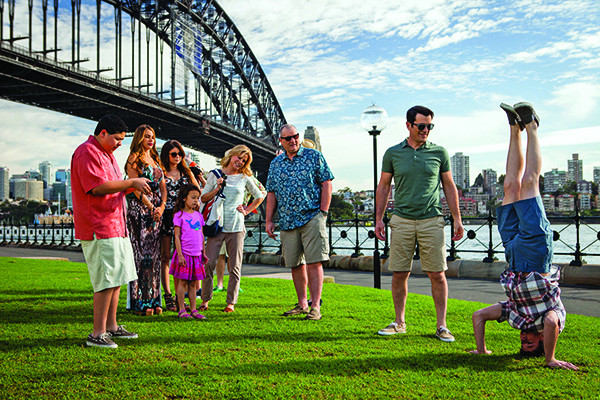 Cast of Modern Family on location
Cast of Modern Family on location
Tibbo’s journey with Modern Family is a testament to his expertise and passion. His accolades, including three Emmy Awards from nine nominations and five CAS Awards from eight nominations, speak volumes about his contribution. However, he humbly acknowledges that these achievements were a team effort. He credits his dedicated crew, including key boom operators Preston Connor (Seasons 1-3) and Serge Popovic (Seasons 4-11), along with second boom operators Dan Lipe and William Munroe, and a host of additional boom operators who contributed over the years. Playback operator Mark Agostino also played a crucial role in the show’s sound production.
What sets Modern Family apart technically is its shooting style. Tibbo explains that despite being a two- to three-camera setup, each scene was approached as a “oner,” meaning continuous, long takes. This presented unique challenges for sound capture. With cameras capturing wide shots, single shots, and two-shots simultaneously, precise communication and coordination with camera operators were essential. The sound team had to anticipate camera movements to ensure clear dialogue recording, a crucial element in a comedy driven by witty exchanges.
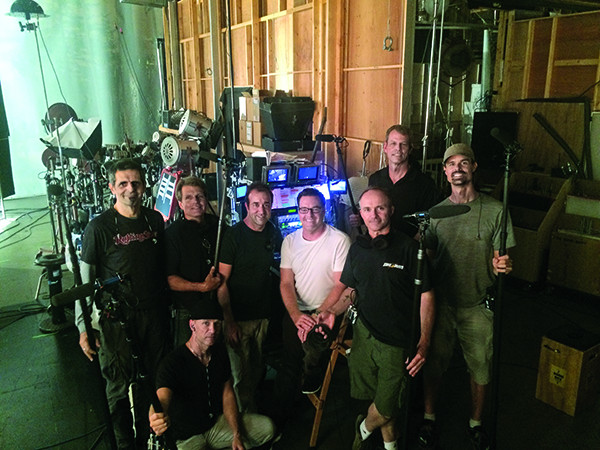 sound crew for “Connection Lost,” day one
sound crew for “Connection Lost,” day one
The sheer size of the cast also added complexity. Tibbo recalls episodes with as many as twelve to fourteen actors in a single scene. To manage this, he utilized advanced recording technology, starting with a Deva and a SD 788, and later upgrading to an O1V96i console and dual Sound Devices 970 recorders with Dante. This setup allowed him to handle a large number of ISO tracks, ensuring every actor’s dialogue was captured cleanly. His innovative monitoring system, using an A/B box to quickly switch between the mix and individual ISO tracks, allowed for efficient problem-solving on set.
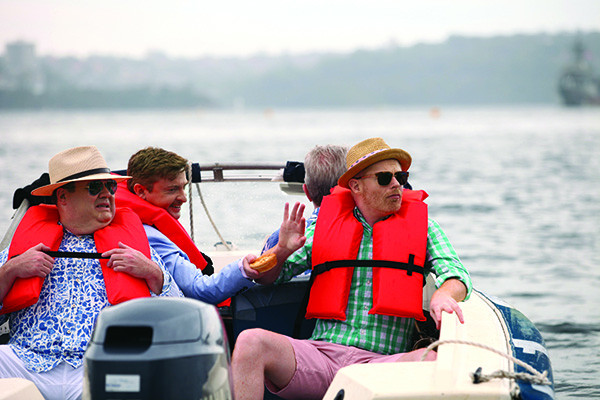 a scene from “Australia” with Eric Stonestreet and Jesse Tyler Ferguson
a scene from “Australia” with Eric Stonestreet and Jesse Tyler Ferguson
One particularly demanding episode, “Can’t Elope,” pushed the sound team to their limits with twenty-five tracks, including nineteen actors, four boom operators, and playback. Tibbo ingeniously cascaded two O1V96i consoles to manage the massive track count, showcasing his adaptability and resourcefulness.
Tibbo’s approach to miking was meticulous. He wired every actor with lavalier microphones at all times to avoid missing any comedic lines, while simultaneously employing boom microphones for optimal sound quality. He invested significant effort in matching the sound of lavaliers and booms, using EQ settings tailored to each actor’s voice. His microphone selection included Countryman B6’s, chosen for their minimal clothing rustle, and Sennheiser MKE 1’s, preferred for outdoor scenes and situations requiring robust sound capture.
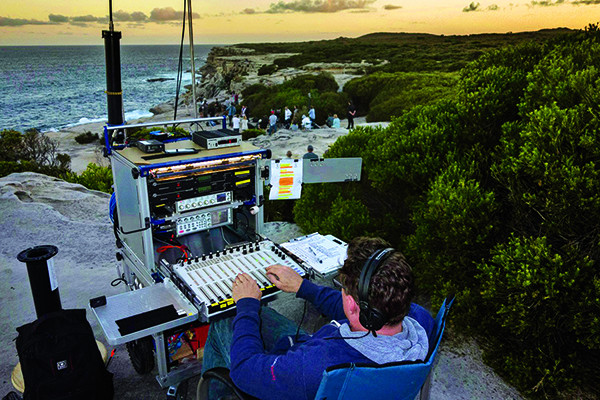 mixing on the medium cart in Australia
mixing on the medium cart in Australia
Equipment played a vital role in Tibbo’s workflow. He relied on Lectrosonics Venue wireless systems, UM400 transmitters for boom operators, and a variety of transmitters for actors, including UM’s, SM’s, SMQ’s, MM’s, and SSM’s. His collection of gear, accumulated over years, reflected a commitment to maximizing investment and having the right tools for any situation.
Preparation was key to Tibbo’s success. He emphasized script reading and attending production meetings to understand the week’s requirements. This proactive approach allowed him to budget for additional resources, whether it was extra boom operators, specialized rigging for car scenes, or playback equipment. He meticulously planned gear needs, ensuring he was always prepared for the diverse and often complex demands of Modern Family.
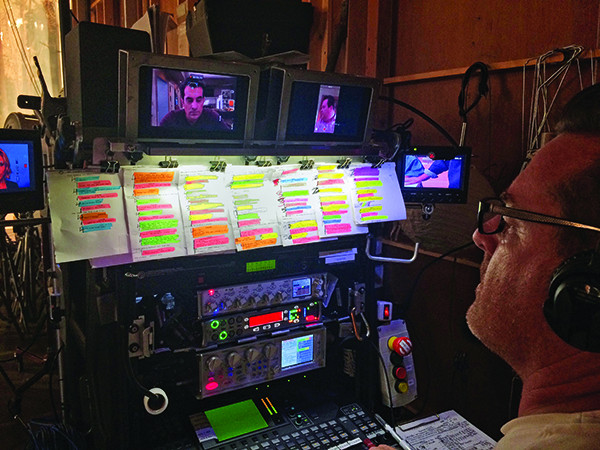 Mixing “Connection Lost”
Mixing “Connection Lost”
Boom microphones were central to the show’s sound. Tibbo’s primary choice was the Schoeps CMIT 5U, with the Schoeps CMC and Sennheiser MKH 50 used in smaller, reverberant sets. For noisy environments like kitchen sets with fan noise, the Sennheiser 8060’s provided a solution. He typically used two boom operators, adding a third for larger scenes, often bringing in Dan Lipe for his expertise. Tibbo developed a “road map” system, marking scenes with “ones, twos, threes, and ‘W'” to guide boom operators and indicate when to use wireless microphones.
The “Connection Lost” episode, famously shot entirely from the perspective of computer screens, presented an extraordinary sound challenge. To achieve the live, simultaneous filming across multiple sets, Tibbo deployed seven boom operators and an IFB technician. He created a complex earwig system, allowing actors on different sets to hear each other while preventing feedback. This intricate setup, involving eleven earwigs and backup units, along with handheld mics for the director and script supervisor, was crucial to the episode’s innovative format.
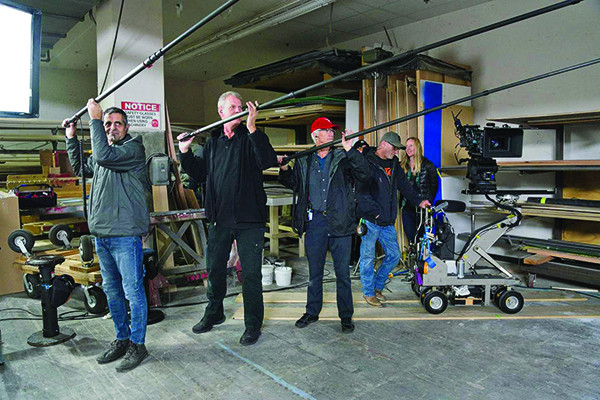 three booms working it out, with Srdjan Popovic, William Munroe, and Dan Lipe
three booms working it out, with Srdjan Popovic, William Munroe, and Dan Lipe
Filming driving scenes often involved insert cars, and Tibbo adapted his techniques accordingly. With windows up, he favored Schoeps BLM03 boundary layer microphones. When windows were down, he switched to Schoeps 41 microphones on Collette mounts or Sennheiser MKE 1’s. His philosophy was to always rig more microphones than needed, ensuring he was prepared for any directorial changes.
Tibbo’s custom “minicart,” built years prior for a Dude Ranch episode, became an invaluable tool. Designed to be compact and versatile, it housed a Zaxcom Mix-8, Deva 5, and Lectrosonics Field Venue, and could be easily detached for insert car work or location shoots. This adaptable cart allowed him to maintain fader control in diverse filming environments.
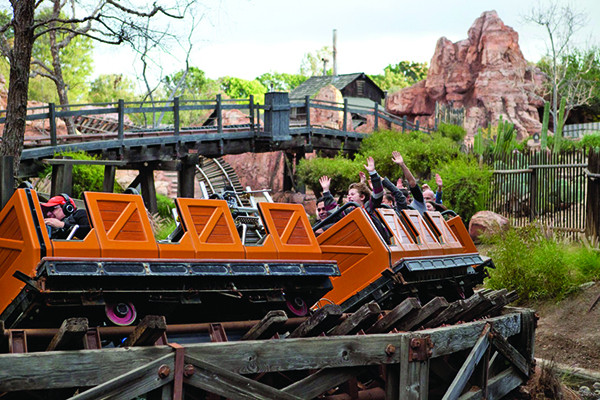 William Munroe booming Season 10
William Munroe booming Season 10
For the Australia episode, logistical challenges arose with equipment shipping and frequency coordination. Tibbo utilized his “medium cart” in Australia, equipped with a Deva Fusion, Nomad, Zaxcom Mix-12, and Mix-8, and rented additional equipment to supplement his setup. Navigating frequency availability differences between Australia and Los Angeles required careful planning and adaptation.
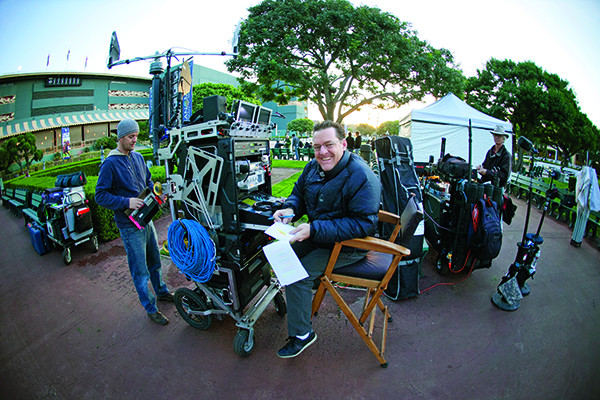 Santa Anita Park with Preston Connor and Dan Lipe
Santa Anita Park with Preston Connor and Dan Lipe
Tibbo’s approach to on-set collaboration was understated yet effective. He prioritized delivering excellent sound without drawing unnecessary attention. However, he wasn’t afraid to speak up when needed, using questions to address potential issues and ensure clarity. He proactively requested wild lines and facilitated ADR sessions on set to minimize actor commute time, fostering a collaborative and efficient workflow. He also lauded the post-production sound team at Smart Post and Fox, highlighting the importance of open communication with Supervising Sound Editor Penny Harold, Dialogue Editor Lisa Varetakis, and Re-recording Mixers Dean Okrand CAS and Brian R. Harman CAS.
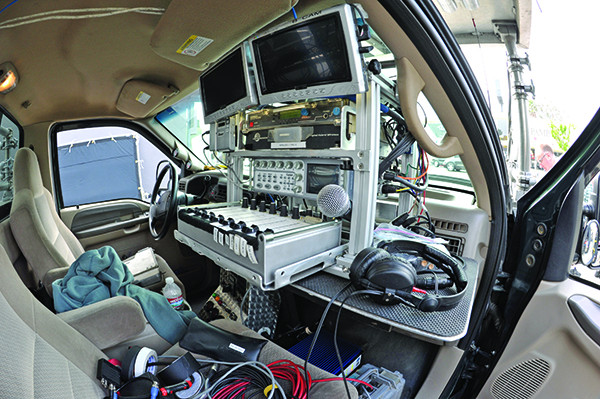 insert car setup
insert car setup
After ten seasons, Tibbo’s enthusiasm for Modern Family remained undiminished. He cherished the ongoing challenges and the rewarding feeling of overcoming them. The show’s enduring appeal lies not only in its humor and relatable characters but also in the dedication of its crew, like Stephen Tibbo and his sound team, who worked tirelessly behind the scenes to create a truly exceptional viewing experience. While you can find Modern Family streaming on platforms like Hulu and Peacock, understanding the intricate craftsmanship behind its sound design adds a new layer of appreciation for this beloved series.
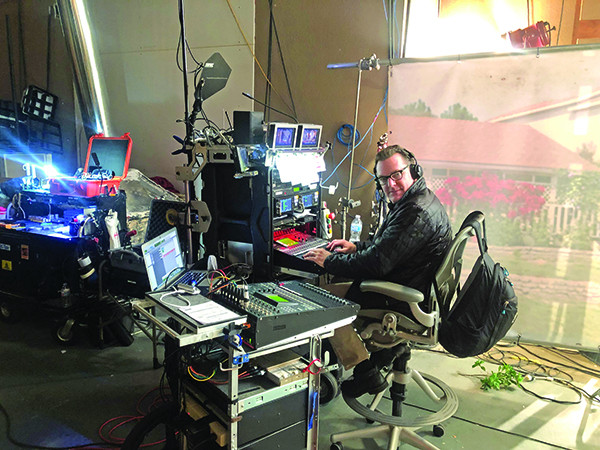 Steve Tibbo CAS mixing on his sound cart.
Steve Tibbo CAS mixing on his sound cart.

